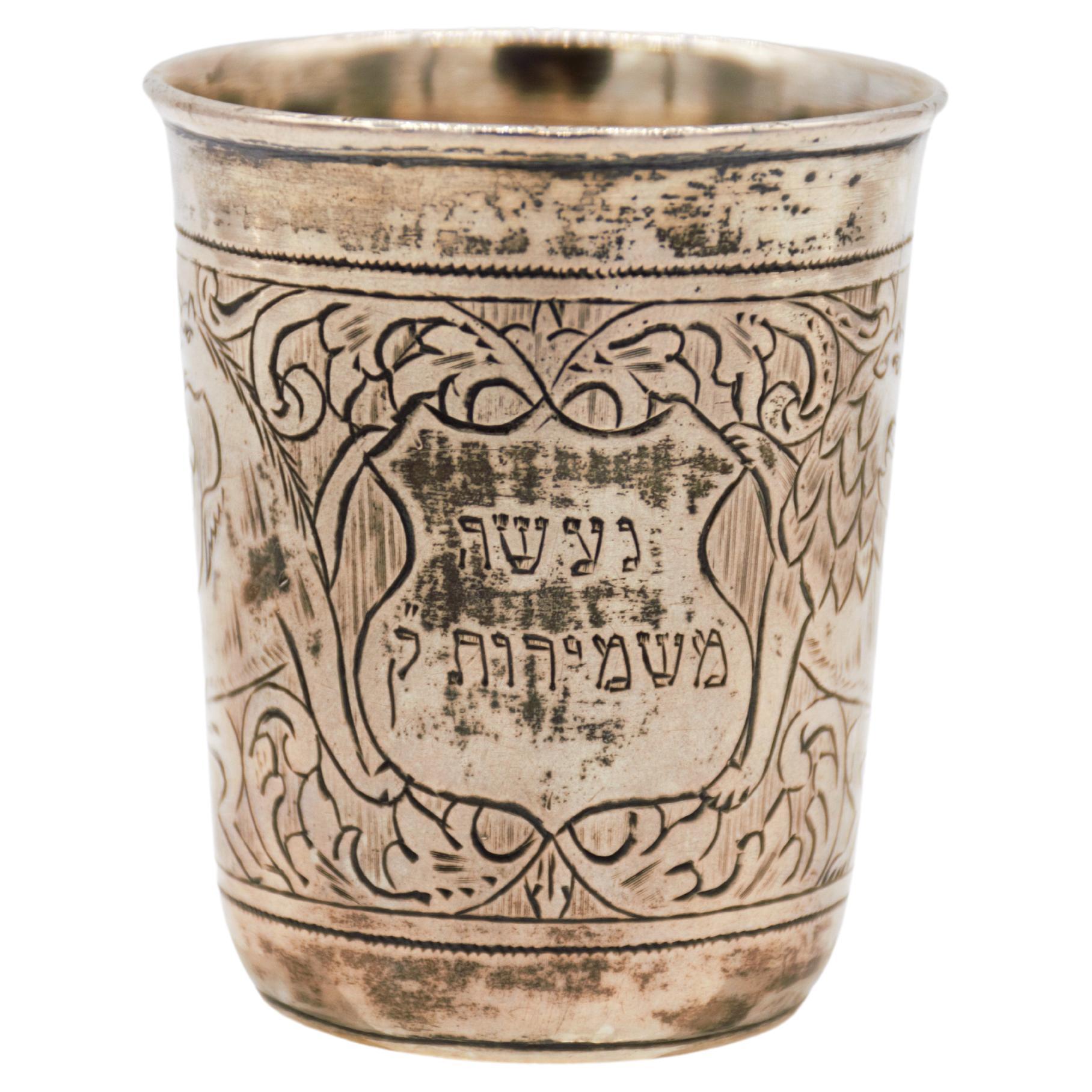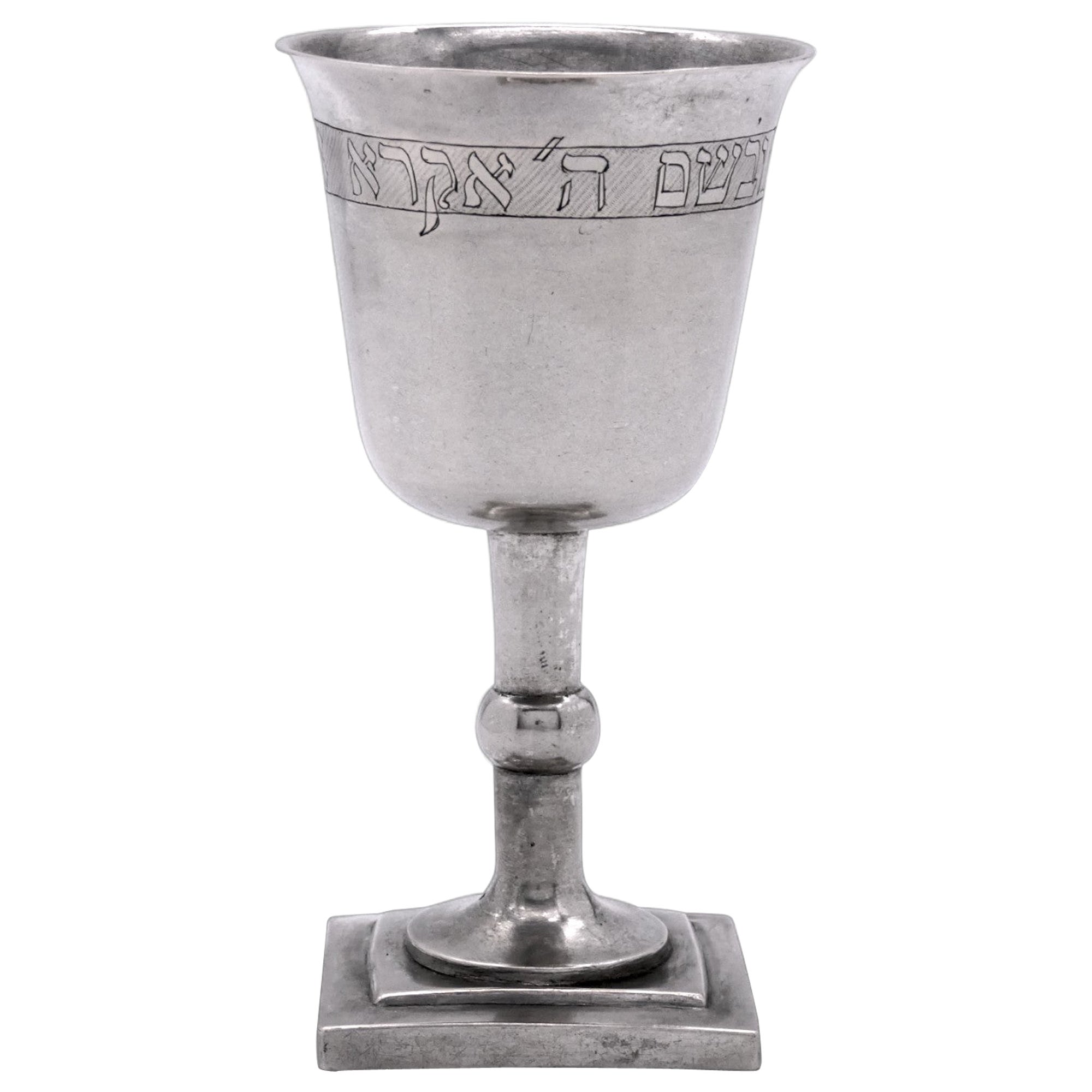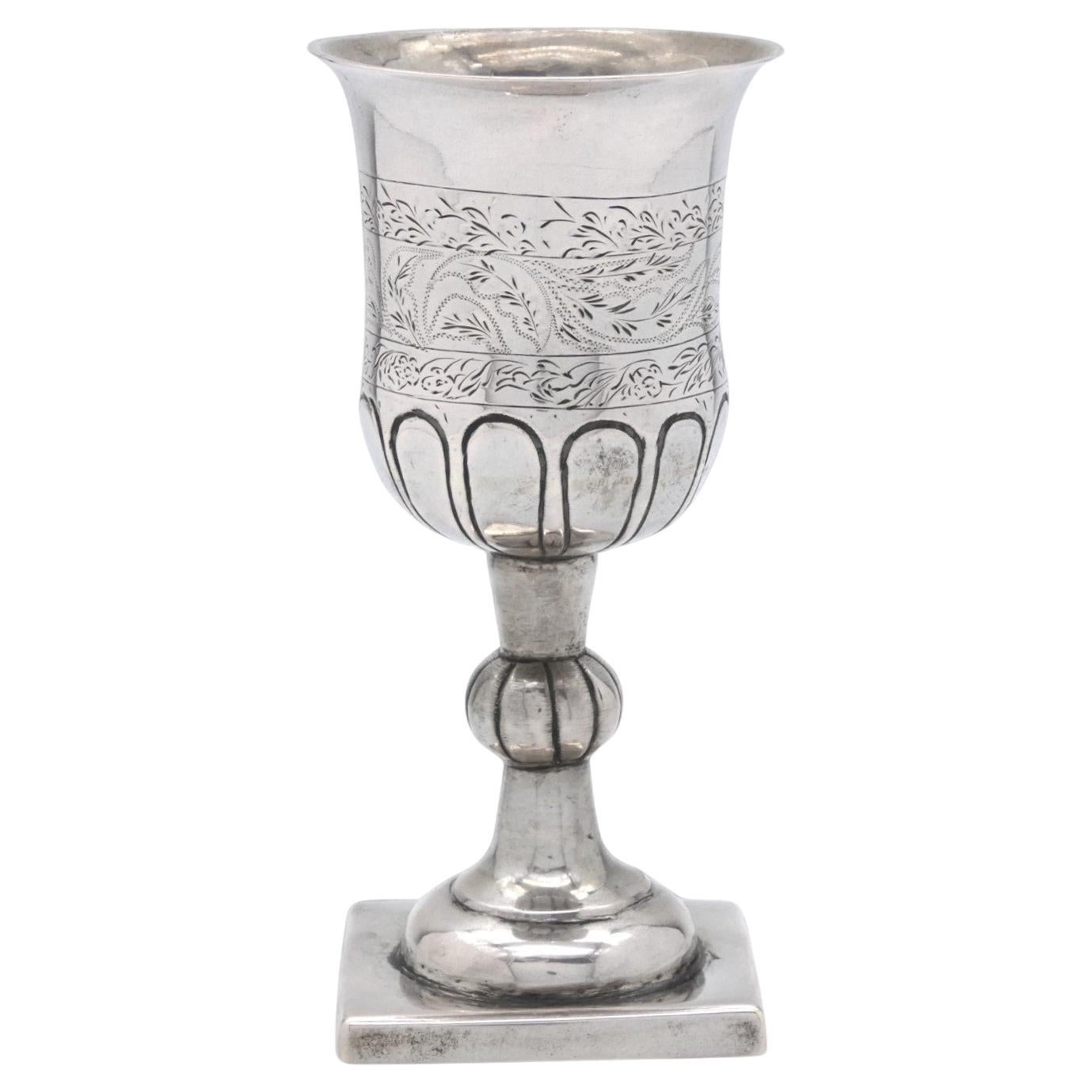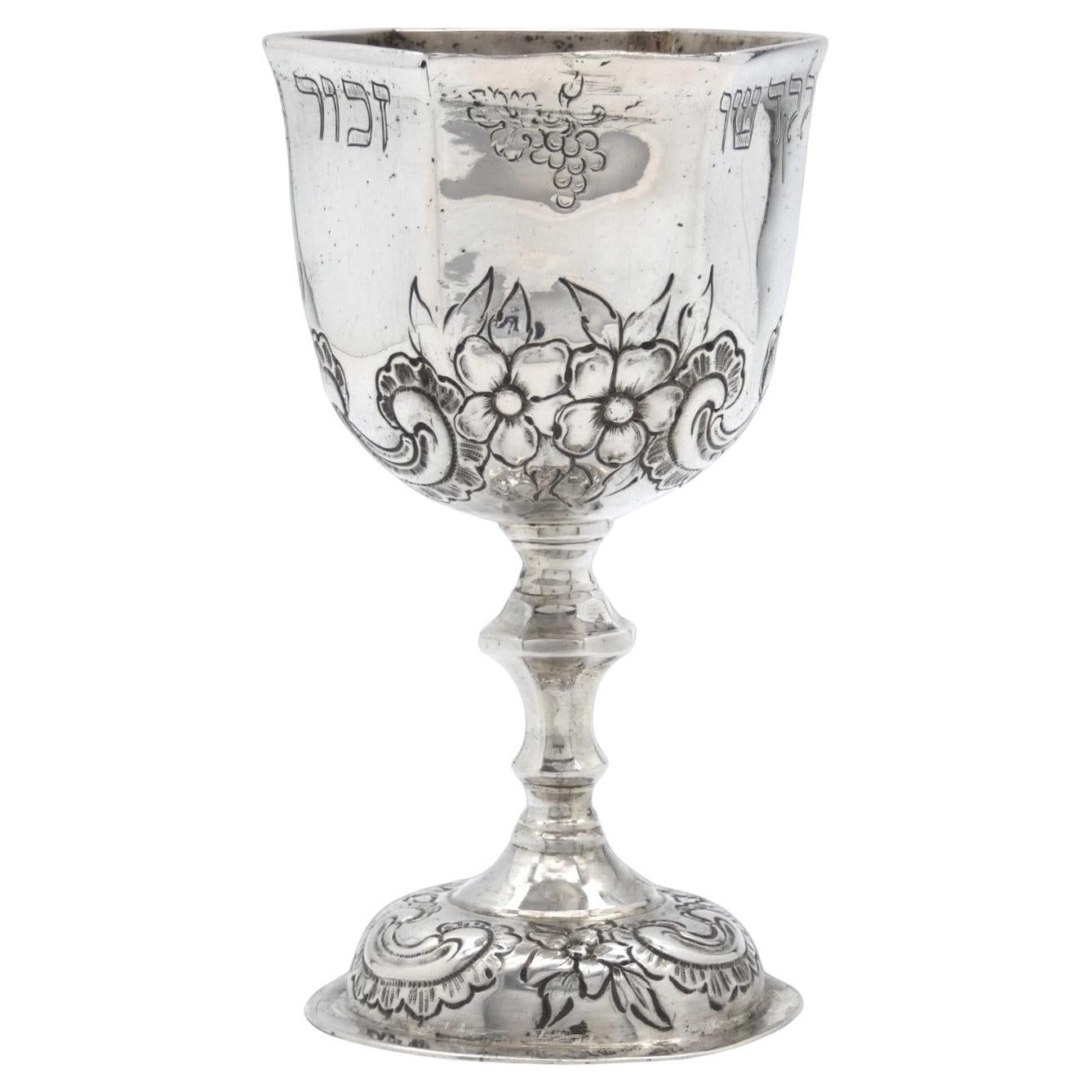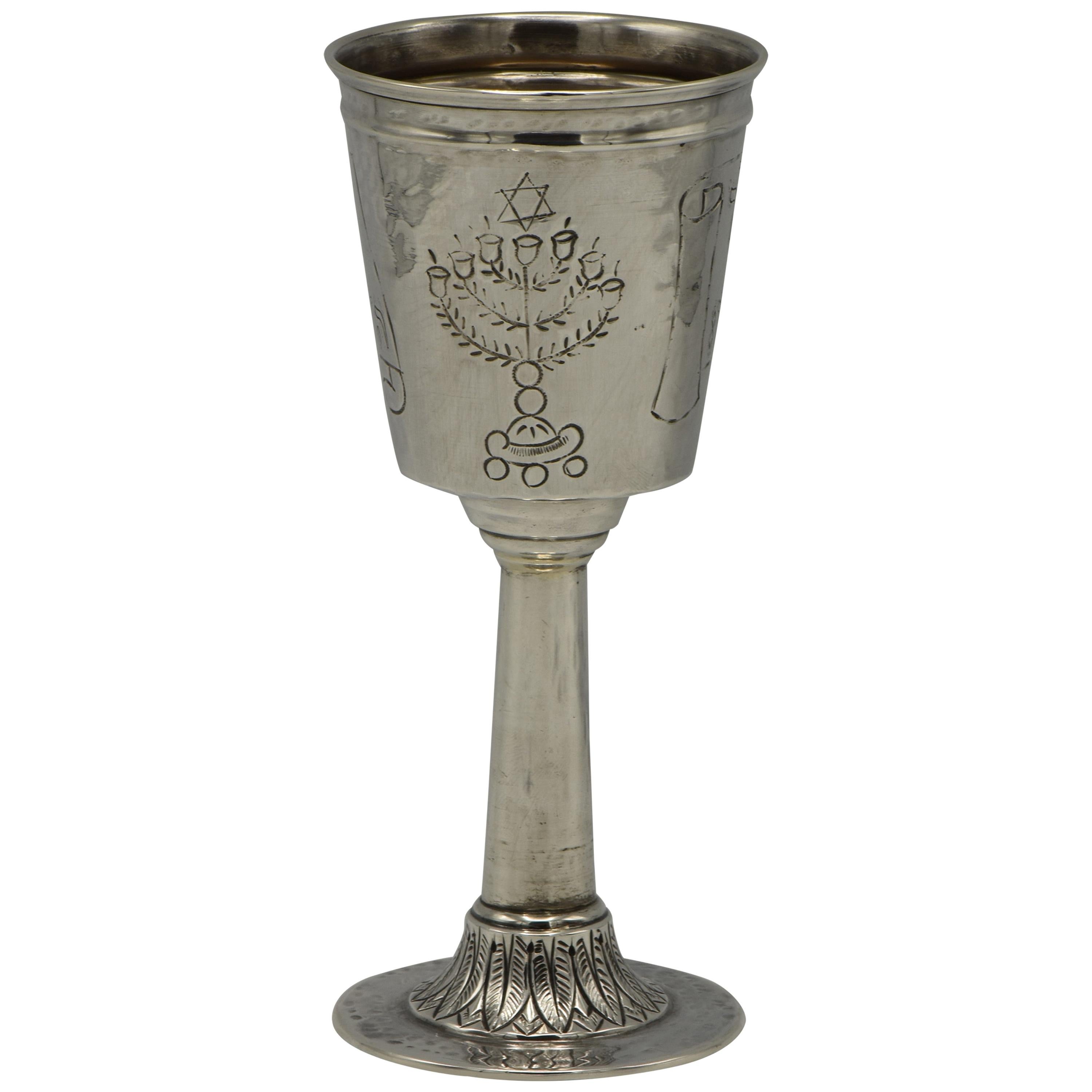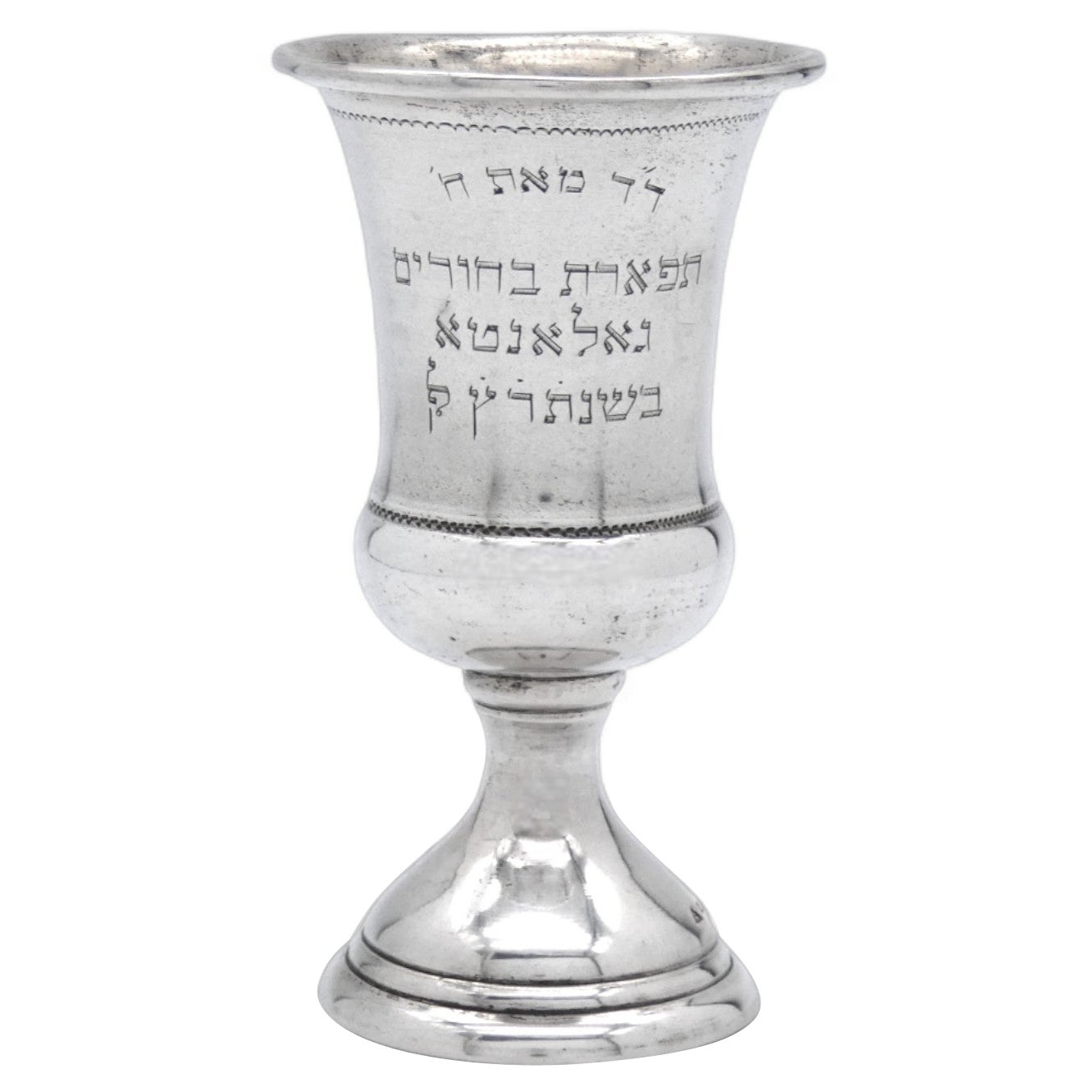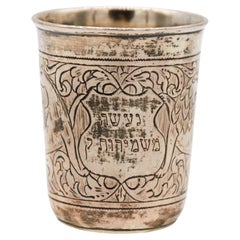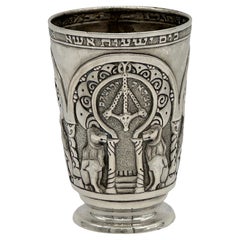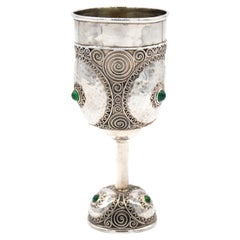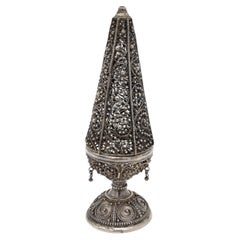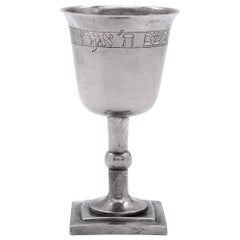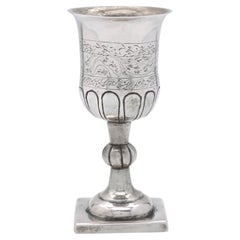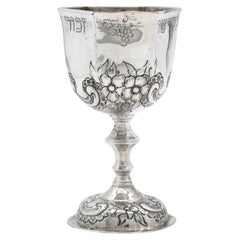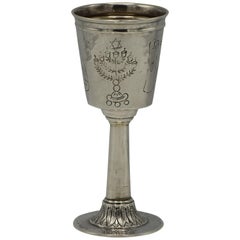Items Similar to Rare "Safed" kiddush cup, late 19th century Poland/ Eretz ISRAEL
Want more images or videos?
Request additional images or videos from the seller
1 of 5
Rare "Safed" kiddush cup, late 19th century Poland/ Eretz ISRAEL
$8,000
£6,040.86
€6,961.43
CA$11,291.40
A$12,448.51
CHF 6,512.66
MX$152,720.11
NOK 81,981.48
SEK 76,665.65
DKK 51,988.18
About the Item
This 84 silver cup was made in Europe, in Poland or parts of Poland that are in modern Russia in the 19th century, the interesting and important in this cup types is that they were sent or brought over to Eretz Israel in the late 19th Century and they were engraved by a famous engraver in the holy city of Safed on the north of Israel, with this act the kiddush cup was getting the "holiness" of the promised land in it, the decoration is just amazing on this Cup and the interesting and rare part here is that most of the times this cups Are simple without a fluted base like we have here in the example, the cup Is marked 84 for the 87.5% of silver content 5 times to the base. Three Medallions delicately engraved with decorations showing the Western Wall, The Cave of Machpelah and the Tombs of the Davidic Kings. Interspersed Between the medallions are engraved decorations of leaves and flowers.
A great addition to any serious Judaica collection or any jewish house.
Size:
Height : 4.6 inch / 11.7 cm
Width : 2.6 inch / 6.5 cm
- Dimensions:Height: 4.6 in (11.69 cm)Diameter: 2.6 in (6.61 cm)
- Materials and Techniques:
- Place of Origin:
- Period:
- Date of Manufacture:1890
- Condition:some minor dents and scratches, consistent with age.
- Seller Location:Tel Aviv - Jaffa, IL
- Reference Number:1stDibs: LU8130237709242
About the Seller
No Reviews Yet
Vetted Professional Seller
Every seller passes strict standards for authenticity and reliability
1stDibs seller since 2023
- ShippingRetrieving quote...Shipping from: Tel Aviv - Jaffa, Israel
- Return Policy
Authenticity Guarantee
In the unlikely event there’s an issue with an item’s authenticity, contact us within 1 year for a full refund. DetailsMoney-Back Guarantee
If your item is not as described, is damaged in transit, or does not arrive, contact us within 7 days for a full refund. Details24-Hour Cancellation
You have a 24-hour grace period in which to reconsider your purchase, with no questions asked.Vetted Professional Sellers
Our world-class sellers must adhere to strict standards for service and quality, maintaining the integrity of our listings.Price-Match Guarantee
If you find that a seller listed the same item for a lower price elsewhere, we’ll match it.Trusted Global Delivery
Our best-in-class carrier network provides specialized shipping options worldwide, including custom delivery.More From This Seller
View AllA RARE SILVER SHMIROT KIDDUSH CUP. Galician, c. 1850.
Located in Tel Aviv - Jaffa, IL
A RARE SILVER SHMIROT KIDDUSH CUP. Galician, c. 1850.
Among some Hassidic courts, it was a practice for the Rabbi to give a blessed silver coin to his Hassidim as an amulet. Such protection might be given for all manner of life events, from healing from an illness to success in travel and the amulet was carried on the body of the recipient. This custom was particularly popular among the Ryzhiner Hassidim and these coins were called "Shmirot". To such coins were attributed extraordinary power and value and they were treasured with great care and love.
this cup is marked with polish loth 12 mark which indicate silver content of 75%.
Size :
Height 2.3 inch / 6 cm
Width : 2 inch / 5 cm
After the specific event for which they had originally be given, such a coin or coins were used in the making of other objects, which maintained the special aura of the Rabbi. Such a coin would be melted in other silver with the amuletic valued being spread evenly to all the silver. Then a ritual object would be fashioned by a silversmith and the special nature of the item would be inscribed on it, indicating in one of several ways that this object had been made from "Shmirot". this objects include Kiddish cups, a Havdalah tray, a Shabbat salt holder, a Chanukkah Menorah, a Torah crown etc.
This object is a Kiddish cup fashioned from such silver. On this cup, the inscription indicating Shmirot is found in the abbreviation of the words "made from shmirot k (kodesh)' " (This is the cup of Shmirot). Such cups were used for blessing the wine so that each use renewed the power of protection granted by the Rabbi. This cup was used for the blessing over wine on Shabbat and holidays. Inscription:
the other iconography on the cup is of a lion that represent Through the tribe of Judah, the lion symbol came to represent the blessing, majesty, and even divine protection of the Jews. The lion symbol continued to be used even after the destruction of Jerusalem, the capital of Judah's nation,
and a unicorn or a re'em, also reëm (Hebrew: רְאֵם), is an animal mentioned nine times in the Hebrew Bible It has been translated as "unicorn" in the Latin Vulgate, King James Version, and in some Christian Bible translations as "oryx" (which was accepted as the referent in Modern Hebrew),[citation needed] "wild ox", "wild bull", "buffalo" or "rhinoceros". Rabbi Natan Slifkin has argued that the re'em was an aurochs, as has Isaac Asimov...
Category
Antique 1850s Sterling Silver
Materials
Silver
Important Early 20th Century Silver Kiddush cup by Bezalel School Jerusalem
Located in Tel Aviv - Jaffa, IL
Important Handmade sterling silver Kiddush goblet by Bezalel School, Jerusalem, Circa 1910-1913.
On the cup there are 3 identical scenes of flanked lions and on the middle of them There are two columns with a staircase, this design is probably taken from Eastern European torah ark, on the middle part there is a chandelier with 3 tiger/lioness Heads, the top of the cup has 3 inscription on top of each flanking lions scene, first One says : ״כוס ישועות אשא״ (Psalms 116:13) which means " I will take the cup of Salvation", this is a rather common blessing on kiddush cups.
Next inscription says : ״אין שמחה אלא ביין״ in English " there is no joy except in wine" This says that after the temple was destroyed we have our joy only in the wine of Kiddish.
The last inscription says ״ושמחת בחגך״ (Deuteronomy 16:14 ) in English : "And you shall rejoice in your festival".
So this cup is a kiddish cup...
Category
Vintage 1910s Israeli Art Nouveau Sterling Silver
Materials
Silver
Important Early 20th Century Silver Kiddush Goblet by Bezalel School Jerusalem
Located in Tel Aviv - Jaffa, IL
Important Handmade sterling silver Kiddush goblet by Bezalel School, Jerusalem, circa 1910-1913.
On round base decorated with silver filigree and Cabouchon shaped green agate applications.
The base fitted with Bezalel mark. The upper portion is all adorned with amazing filigree work, the base and the actual cup adorned with swirling filigree designs, in the middle there are 3 roundels, made in another technique of hammered silver, similar to the works that were produced in this time all over Europe, in the middle of each roundel there is a perfectly centered Cabouchon green agate.
This work is attributed to Yehia Yemini.
The goblet is marked on the base, with the earliest silver mark of the school that just say "Bezalel" in Hebrew.
Yehia Yemini :
Was one of the biggest and must famous Bezalel silver...
Category
Early 20th Century Israeli Jugendstil Sterling Silver
Materials
Silver
Early 20th Century Silver Spice Tower by Yehia Yemini, Bezalel School Jerusalem
Located in Tel Aviv - Jaffa, IL
Very rare Bezalel Jerusalem silver filigree spice tower, this amazing spice Tower was Made by Yehia Yemini, who was the best filigree artist in bezal...
Category
Vintage 1920s Israeli Sterling Silver
Materials
Silver
JUDAICA SILVER ETROG BOX DESIGNED BY LUDWIG WOLPERT. New York, 20th century
Located in Tel Aviv - Jaffa, IL
This charming piece of jewish history in front of you is a one of kind modern Judaica object,
This box used to hold the Etrog To protect the it during the holiday of Sukkot, it is traditionally Wrapped in silky flax fibers and stored in a special decorative box, mostly made from silver.
Wolpert designed this amazing hand hammered Bauhaus style box in 1963-1964 while he was Working in New York. all of the boxes we could found from this design made by Wolpert have The upper part inscribed in a simple engraving with the phrase "Pri Etz Hadar"
In Hebrew ״פרי עץ הדר״. the box in front of you is the only example in existence as far as we Know where the letters are also repoussé and also engraved, such a beautiful and hard to get Combination, the rest of the box is shaped as a modernistic Etrog, all the body of the box is Skillfully hand hammered in a way it reflects the light in a warm and calm way, a true Masterpiece of modern judaica by the great and important artist Ludwig Yehuda Wolpert.
One of the the two great masters of 20th century Judaica.
the Box is marked "WOLPERT" AND "STERLING" and the base has the engraved inscription :
"ALAN WECHSLER GENERAL CHAIRMAN, ALLIED JEWISH APPEAL OF SOUTHERN NEW JERSEY 1978"
Similar boxes can be find in museum collections around the world
In the Jewish Museum New York
In the North Carolina Museum of Art
In The Derfner Judaica Museum
Another similar box was featured in the Israel Museum exhibition
"Forging Ahead, Wolpert and Gumbel, Israeli Silversmiths for the Modern Age"
Ludwig Yehuda Wolpert was born in Hildesheim, Germany, to an Orthodox family. In 1916-1920, He began his studies in sculpture at the Frankfurt School of Art. In 1925-1928, he studied Goldsmithing at the Frankfurt School of Art.
Following the presentation of the works in the 1930 exhibition "Kult und Form" ("Ritual and Form") at the Jewish Museum in Berlin, his works became well known in the German Jewish World. His works were greatly influenced by Modernist design, especially the Bauhaus Movement. Wolpert's works avoid decoration, relying on clean, geometric shapes. In 1933, Following the Nazi rise to power in Germany, he immigrated to the Mandatory Palestine with His family. There he worked for two years in the workshop of Bernhard Friedländer, where he Designed and produced silverware and Jewish ceremonial art.Together with Victor Solomon...
Category
Vintage 1960s Decorative Boxes
Materials
Silver
extremely rare Algerian Judaica silver, jewish Dowry box early 19th century
Located in Tel Aviv - Jaffa, IL
Amazing and scarce JUDAICA object, we have here one of the most touching jewish objects we had for a long time, this small silver dowry box was made in Algeria in the early 19th century, it is all covered with symbols of jewish faith and of couples, the sliding lid has 2 flanking birds with hamsa (protective hand) on each side and a flower vase in the middle.
one side shows two flanking lions with a tree in the middle and the other side shows again two big and two small birds with a flower bowl in the middle, front side has a key hole and next to it there is the Hebrew inscription ס״ט״" which says Siman tov or in English "a good sign" it is taken from the wedding blessing, underneath the lock there is another inscription with the name ״עזיזה בת אברהם בן חמו״ which is the name of the bride, her father and her grandfathers name.
the box is full marked a lot of times with the silversmith mark, every side of the box is marked.
this box was probably ordered by the grooms family to hold the jewelry they are giving to the bride as dowry, this type of objects are rare and there are just a few of them on museum collections.
DOWRY (Heb. נְדֻנְיָה), the property a wife brings to her husband at marriage; the Yiddish equivalent, nadn, is from the same root. The custom of nedunyah became clearly defined and institutionalized only in the talmudic period. In biblical times, mohar (מֹהַר), whereby the groom bought his wife from her father (Gen. 24:53; Ex. 22:15–16; Hos. 3:2), was the accepted practice. It was then customary that the groom give the bride gifts, and that she bring certain property to her husband's home upon marriage: slaves, cattle, real estate, etc. (cf. Gen. 24:59–61; 29; Judg. 1:14ff.; I Kings 9:16). Evidence of the custom of nedunyah is to be found in Tobit (7:14; 8:21) and in the Assuan papyri (Cowley, Aramaic, nos. 15, 18). Gradually, mohar was superseded by the ketubbah custom according to which the husband merely assumed the responsibility of compensation to his wife in case he divorced her: he had to pay her 200 zuzim if she had been a virgin at the time of marriage, and 100 zuzim if a widow or divorcée (see *Ketubbah).
By talmudic times, the institution of nedunyah was prevalent; the father gave a dowry to the bride since the daughter was excluded from paternal inheritance. Fifty zuzim (equivalent to the worth of 180 grams of silver) was the minimum amount a father was obliged to give to his daughter (Ket. 6:5). Parents usually gave much more, according to their social standing. Community funds provided the dowry for an orphan or a very poor girl (ibid.; cf. Sh. Ar., YD 251:8). In case of her father's death, the brothers of a minor girl were obliged to give her the minimum dowry, and the court estimated how much her father would have given her above the minimum dowry. The sum was then taken out of the father's estate and given to the daughter upon majority (Ket. 6:6; 68a–69b). In the absence of such an estimate, each daughter was entitled to receive one-tenth of the value of her father's estate in money, or in valuables (Yad, Ishut, 20:4–7; Sh. Ar., EH 113:4). If the father was unable or unwilling to pay the promised dowry at the betrothal ceremony, the groom could refuse to marry his bride (Ket. 13:5; Ket. 108b–109a). Insistence on exact payment of the promised dowry, however, was frowned upon by later rabbinic authorities (Rema to Sh. Ar., EH 2:1). In certain communities it was customary for the groom's father to make a dowry contribution equal to that of the bride's father (Ket. 102b). The dowry, whether given in real estate, slaves, money, or chattel was recorded in the marriage contract (the ketubbah) and in some instances one-third or one-fifth of the actual value of the dowry was added to the sum mentioned in the ketubbah. Based upon a decree enacted by *Simeon b. Shetah (first century C.E.), the Talmud ruled that the husband and his entire property were liable for compensation as stipulated in the ketubbah, either in case he died (when she collected the sum specified in the ketubbah from the heirs) or in case he divorced his wife (Ket. 82b). For the status of the dowry and the husband's rights and obligations, see below. The rabbinic enactments (Takkanot Shum) by R. Jacob *Tam and by the rabbinic synod of the communities of Speyer, Worms, and Mainz (Germany) stipulated that if a woman died...
Category
Antique Mid-19th Century Algerian Tribal Art
Materials
Silver
You May Also Like
A Silver Kiddush Goblet, Poland mid 19th Century
Located in New York, NY
A Refined Silver Kiddush Goblet, made in Poland in the mid-19th Century.
This Polish Kiddush Goblet has an interesting feature about it. On the upper body, there is a Hebrew verse e...
Category
Antique Mid-19th Century Polish Sterling Silver
Materials
Silver
$4,000 Sale Price
20% Off
A Silver Kiddush Goblet, Poland mid 19th Century
Located in New York, NY
A Dignified Silver Kiddush Goblet, made in Poland in the mid-19th Century.
This Polish goblet is one of the most commonly used silver Kiddush Goblets in the Polish, Ukrainian, and G...
Category
Antique Mid-19th Century Polish Sterling Silver
Materials
Silver
$2,000 Sale Price
42% Off
A Silver Kiddush Goblet, Germany 19th Century
Located in New York, NY
A Lovely Silver Kiddush Goblet made in Germany in the 19th Century
Kiddush Goblets such as these were fairly common in many households in Germany during the 19th century.
Kiddush G...
Category
Antique 19th Century German Sterling Silver
Materials
Silver
$1,600 Sale Price
54% Off
Mid-20th Century Israeli Silver Kiddush Goblet by Moshe Smilovici
Located in New York, NY
Hand-hammered silver Kiddush goblet, Moshe Smilovici, Tel Aviv, Israel, circa 1950.
On round base engraved with leaves and tall stem. Upper wine section is engraved with the temple ...
Category
Mid-20th Century Israeli Religious Items
Materials
Silver
$980 Sale Price
20% Off
A Silver Kiddush Goblet, Hungary Circa 1930
Located in New York, NY
A Dedicated Silver Kiddush Goblet, made in Hungary Circa 1930.
Seemingly this Kiddush Goblet was donated pre-WWll by a youth group in Galanta which at that time was part
of Hungary...
Category
Early 20th Century Hungarian Sterling Silver
Materials
Silver
$2,800 Sale Price
20% Off
A Silver Kiddush Goblet, Germany 18th Century
Located in New York, NY
An Important Silver Kiddush Goblet made in Germany in the 18th Century.
Goblet rests on a circular domed base with floral scrolling encircling the base.
Knopped trophy stem support...
Category
Antique 18th Century German Sterling Silver
Materials
Silver
$5,200 Sale Price
20% Off
More Ways To Browse
Rare Antique Hammers
Antique Kiddush Cup
Antique Kiddush Cups
Antique Silver Kiddush Cup
Sterling Silver Table Ornament
Tiffany Repousse
Tiffany Silver Shell
Unusual Spoons
Used Gloster Furniture
Vesta Cases
Antique Glass Bank
Antique Ring Dish
Antique Shoe Horns
Antique Tea Caddy Spoon
Art Deco Silver Creamer
Birmingham Art Deco Silver
Chinese Silver Goblet
Enamel Spoon Set
